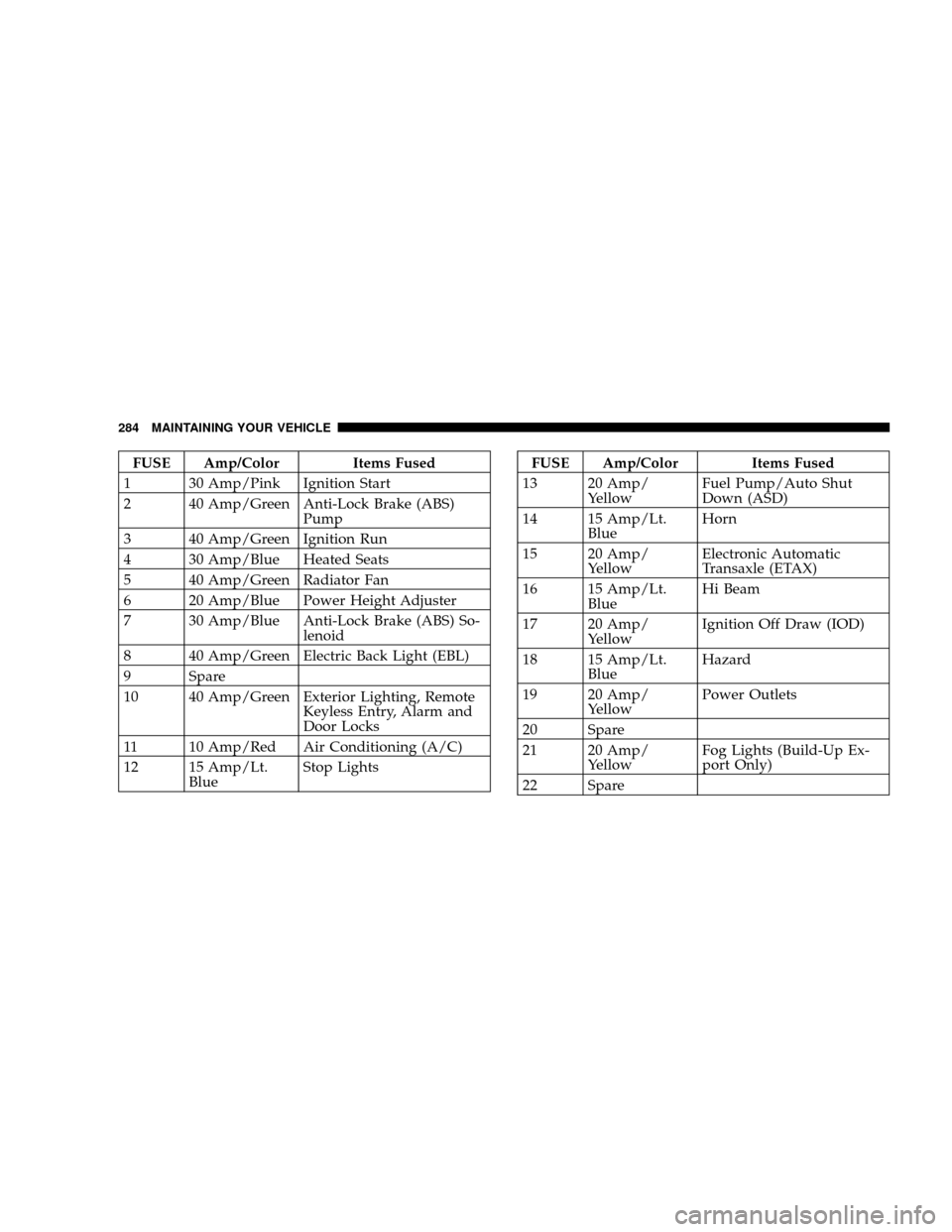stop start CHRYSLER PT CRUISER 2004 1.G Owner's Manual
[x] Cancel search | Manufacturer: CHRYSLER, Model Year: 2004, Model line: PT CRUISER, Model: CHRYSLER PT CRUISER 2004 1.GPages: 341, PDF Size: 5.06 MB
Page 235 of 341

100 ft. lbs (135 N´m). If you doubt that you have
tightened the nuts correctly, have them checked with a
torque wrench by your dealer or at a service station.
8. Remove the wheel blocks and lower the jack until it is
free. Stow the lug wrench, and jack in their designated
location. Secure all parts using the means provided.
WARNING!
A loose tire or jack thrown forward in a collision or
hard stop could endanger the occupants of the ve-
hicle. Always stow the jack parts and the spare tire in
the places provided.
9. Place the deflated (flat) tire in the cargo area,have the
tire repaired or replaced as soon as possible.
WARNING!
A loose tire thrown forward in a collision or hard
stop could injure the occupants in the vehicle. Have
the deflated (flat) tire repaired or replaced immedi-
ately.
10. Check the tire pressure as soon as possible. Correct
pressure as required.
JUMP-STARTING PROCEDURES DUE TO A LOW
BATTERY
WARNING!
Take care to avoid the radiator cooling fan whenever
the hood is raised. It can start anytime the ignition
switch is on. You can be hurt by the fan.
WHAT TO DO IN EMERGENCIES 235
6
Page 238 of 341

7. Start the engine in the vehicle that has the booster
battery, let the engine idle a few minutes, then start the
engine in the vehicle with the discharged battery.
8. When removing the jumper cables, reverse the se-
quence exactly. Be careful of the moving belts and fan.
DRIVING ON SLIPPERY SURFACES
Acceleration
Rapid acceleration on snow covered, wet, or other slip-
pery surfaces may cause the front wheels to pull errati-
cally to the right or left. This phenomenon occurs when
there is a difference in the surface traction under the front
(driving) wheels.
WARNING!
Rapid acceleration on slippery surfaces is danger-
ous. Unequal traction can cause sudden pulling of
the front wheels. You could lose control of the
vehicle and possibly have an accident. Accelerate
slowly and carefully whenever there is likely to be
poor traction (ice, snow, wet, mud, loose sand, etc.).
Traction
When driving on wet or slushy roads, it is possible for a
wedge of water to build up between the tire and road
surface. This is hydroplaning and may cause partial or
complete loss of vehicle control and stopping ability. To
reduce this possibility, the following precautions should
be observed:
1. Slow down during rainstorms or when roads are
slushy.
238 WHAT TO DO IN EMERGENCIES
Page 252 of 341

The best time to check the engine oil level is about 5
minutes after a fully warmed engine is shut off or before
starting the engine after it has sat overnight.
Checking the oil while the vehicle is on level ground, will
improve the accuracy of the oil level readings. Maintain
the oil level between the MIN and MAX markings on thedipstick. Adding one quart of oil when the reading is at
the MIN mark will result in a MAX reading on these
engines.
CAUTION!
Overfilling the crankcase as indicated by an oil level
above the ªMaxº mark on the engine oil dipstick
will cause oil aeration, which can lead to loss of oil
pressure and an increase in oil temperature. This
could damage your engine.
Change Engine Oil
Road conditions and your kind of driving affects the
interval at which your oil should be changed. Check the
following list to decide if any apply to you.
²Day and night temperatures are below 32ÉF (0ÉC).
²Stop and Go driving.
252 MAINTAINING YOUR VEHICLE
Page 257 of 341

CAUTION!
Damage to the catalytic converter can result if your
vehicle is not kept in proper operating condition. In
the event of engine malfunction, particularly involv-
ing engine misfire or other apparent loss of perfor-
mance, have your vehicle serviced promptly. Contin-
ued operation of your vehicle with a severe
malfunction could cause the converter to overheat,
resulting in possible damage to the converter and the
vehicle.
WARNING!
A hot exhaust system can start a fire if you park over
materials that can burn. Such materials might be
grass or leaves coming into contact with your ex-
haust system. Do not park or operate your vehicle in
areas where your exhaust system can contact any-
thing that can burn.
In unusual situations involving grossly malfunctioning
engine operation, a scorching odor may suggest severe
and abnormal catalyst overheating. If this occurs, stop
the vehicle, turn off the engine and allow it to cool.
Service, including a tune up to manufacturers specifica-
tions, should be obtained immediately.
MAINTAINING YOUR VEHICLE 257
7
Page 284 of 341

FUSE Amp/Color Items Fused
1 30 Amp/Pink Ignition Start
2 40 Amp/Green Anti-Lock Brake (ABS)
Pump
3 40 Amp/Green Ignition Run
4 30 Amp/Blue Heated Seats
5 40 Amp/Green Radiator Fan
6 20 Amp/Blue Power Height Adjuster
7 30 Amp/Blue Anti-Lock Brake (ABS) So-
lenoid
8 40 Amp/Green Electric Back Light (EBL)
9 Spare
10 40 Amp/Green Exterior Lighting, Remote
Keyless Entry, Alarm and
Door Locks
11 10 Amp/Red Air Conditioning (A/C)
12 15 Amp/Lt.
BlueStop LightsFUSE Amp/Color Items Fused
13 20 Amp/
YellowFuel Pump/Auto Shut
Down (ASD)
14 15 Amp/Lt.
BlueHorn
15 20 Amp/
YellowElectronic Automatic
Transaxle (ETAX)
16 15 Amp/Lt.
BlueHi Beam
17 20 Amp/
YellowIgnition Off Draw (IOD)
18 15 Amp/Lt.
BlueHazard
19 20 Amp/
YellowPower Outlets
20 Spare
21 20 Amp/
YellowFog Lights (Build-Up Ex-
port Only)
22 Spare
284 MAINTAINING YOUR VEHICLE